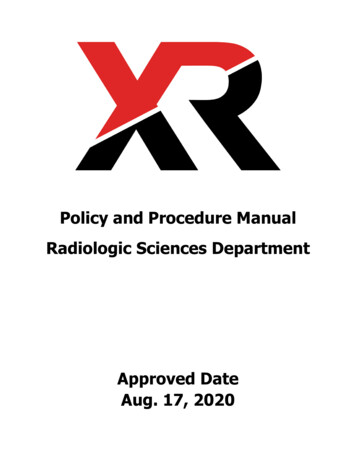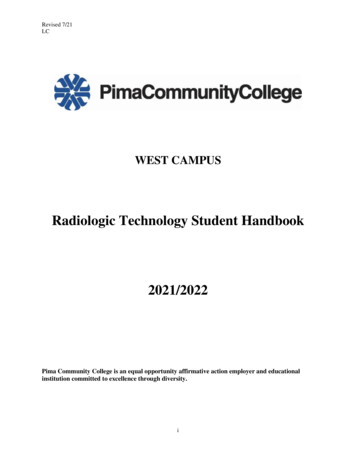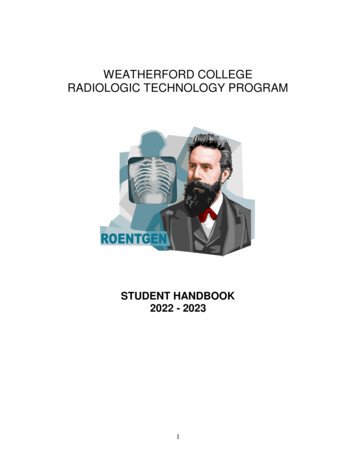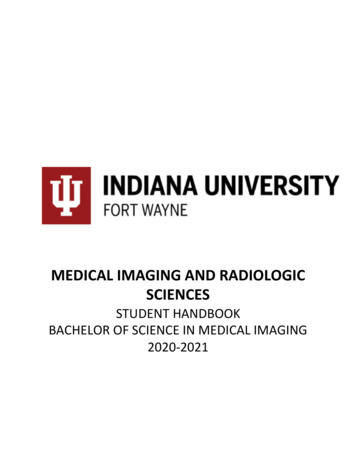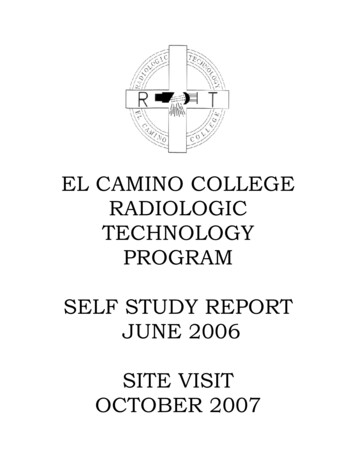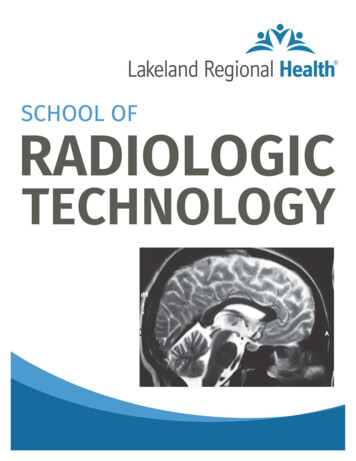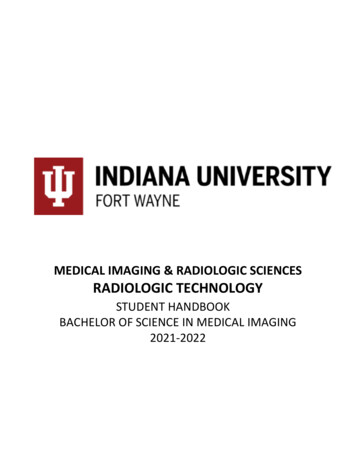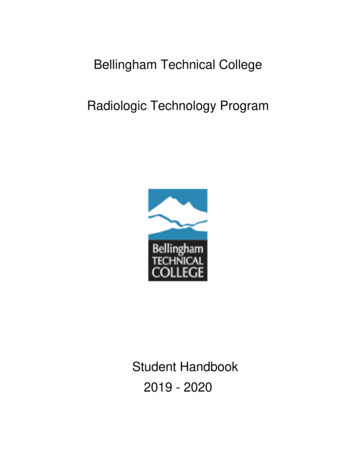
Transcription
Bellingham Technical CollegeRadiologic Technology ProgramStudent Handbook2019 - 2020
TABLE OF CONTENTSPROGRAM DESCRIPTION AND OVERVIEW4OUTCOMES5ACCREDITATION6STUDENT EXPENSE7CURRICULUM10STUDENT POLICIES11I.ADMISSIONSII.SCHEDULINGIII. ATTENDANCEIV. GRADING AND ACADEMIC PROGRESSV.CLINICAL PERFORMANCE EVALUATIONSVI. CLINICAL OBJECTIVESVII. CLINICAL COMPETENCYVIII. CLINICAL GRADINGIX. CLINIC PROBATIONX.PROFESSIONALISMXI. APPEARANCE & DRESS STANDARDSXII. ACADEMIC REQUIREMENTSXIII. SAFETYXIV. CLIENT CONFIDENTIALITYXV. DRUG AND ALCOHOL POLICYXVI. PREGNANCYXVII. RECORDSXVIII. CERTIFICATIONXIX. EMPLOYMENT POLICYXX. TRANSPORTATIONXXI. ARRT STANDARDS OF PENDIX A40PROGRAM FORMS41
In addition to all of the policies, procedures, and rules of the Radiologic TechnologyProgram, all of the policies, rules, and regulations of Bellingham Technical College,as published in the College Catalog and Student Handbook apply to students in theBellingham Technical College Radiologic Technology Program.The College and/or Program policies, procedures, rules, and regulations are subjectto change and revision at any time.Bellingham Technical CollegeProgram FacultyTracy BaileyProgram CoordinatorDidactic & Clinical FacultyHeather WallaceDidactic & Clinical FacultyMichelle StarkDidactic & Clinical Adjunct Faculty
Radiologic Technology ProgramOverviewBellingham Technical College's Radiologic Technology program presents an innovativeapproach to serve students and the community through education in radiography. Regionalsupport of the program through involvement of a supportive health care community andconsortium of colleges provide a solid basis for student success.Students accepted into the radiologic technology program will receive academic and clinicaleducation through a variety of learning technologies. Coursework delivery is may be through theInternet, computer lab activities, video conferencing, radiology lab activities, and the traditionalclassroom. Clinical education will be provided in a variety of settings and prepare the student forwork as an entry-level radiologic technologist.Students accepted into the radiologic technology program students are assigned into a cohortgroup. Students will be required to attend meetings at distant sites during the program.Students will gather together at least once a quarter, and perhaps more, dependent onindividual course requirements. The consortium of colleges supporting the program's regionalapproach to radiology education will provide prerequisite courses and student support services.Consortium colleges include Bellingham Technical College, Edmonds Community College,Everett Community College, North Seattle Community College, Peninsula College, Skagit ValleyCollege and Whatcom Community College.Radiologic Technology Program DescriptionThe Radiologic Technology program at Bellingham Technical College is a sequenced programof courses that fulfill the educational objectives established by the American Society ofRadiologic Technologists and competencies outlined by the American Registry of RadiologicTechnologists. The program takes 21 months to complete and upon successful programcompletion, students are granted an Associate's degree in Applied Science (AAS). Programgraduates are eligible to apply to take the national certification examination administered by theAmerican Registry of Radiologic Technologists. Successful completion of the registryexamination results in national certification as a Registered Radiologic Technologist, RT (R)ARRT.4
Program OutcomesThe Radiologic Technology program curriculum is designed to prepare students to be entrylevel radiographers who are members of the health care delivery team. Technical andprofessional competency development will involve the following Program Outcomes. Aftersuccessfully completing this program, students will be able to:1. RADIATION PROCTECTION: Consistently and appropriately, apply radiationprotection practices and general safety guidelines when administering ionizing radiationtechniques to fully protect the patient, occupational workers (self and other technologists)and non-occupational workers (other members of the healthcare team).2. PROCEDURES: Competently and consistently performs clinical procedures andprotocols of each radiographic position to produce an optimal and diagnostic study.3. IMAGE PRODUCTION: Competently and consistently, produce diagnosticradiographic images, with ability to accurately assess errors and make appropriatecorrections according to standard image evaluation criteria.4. PATIENT CARE: Interact in a compassionate, respectful manner assessing patientcondition and concerns: provides for patient safety, comfort, confidentiality, modesty, andoverall best interest of the patient.5. PROFESSIONALISM AND ETHICS: Conducts herself/himself in a professionalmanner according to ARRT and ASRT standards. Assess situations, exercise care,discretion and judgment; assume responsibility for professional decisions; and able towork in team relationships that support colleagues.6. RETENTION: Successful completion of the program within a 24-month time period.5
RADIOGRAPHY EDUCATIONRadiography education is a systematic process that offers opportunities for students to acquirethe psychomotor, cognitive, and affective behaviors required of a registered radiographer in theprovision of safe, effective client care in the radiology setting. Radiography education providesresources, facilities, a program of learning, and an environment in which the student has anopportunity to test ideas, analyze mistakes, take risks, develop creativity, and evaluate outcomes.The educational process progresses from simple to complex and actively involves the student inwhat will become a lifelong learning process. Like radiography practice, radiography educationfollows theories and principles from various disciplines. The program of learning is based on theprogram philosophy and expected outcomes, and incorporates influences of the school andgeographic setting in which the program is located. Continuous review and revision of institutionaland program philosophy and outcome expectations provides for currency in radiographyeducation. The responsibility for learning belongs to the student, and the faculty serves asorganizers, resource persons, facilitators, role models, and evaluators. The faculty plan learningexperiences in which students think carefully and thoroughly about situations and are motivatedto use their cognitive skills in a responsible manner.The nature of hands on learning does require that students participate in role-play activities inacademic classes.For example, while learning positioning and procedures students willparticipate in laboratory assignments that require a student in the role of “Tech” positioning astudent in the role of “client”. Students will treat each other in these scenarios with the samerespect they demonstrate to clients in the clinical settings.Documentation of consent forparticipation in these role-playing demonstrations is required for progress in this program.ACCREDITATIONThe BTC Radiologic Technology Program is accredited by The Commission on Colleges,Northwest Association of Schools and CollegesBellevue, Washington, 98004.11300 NE 33rd Place, Suite 120,The Commission is an institutional accrediting bodyrecognized by the Council for Higher Education Accreditation and the U.S. Department ofEducation.6
STUDENT EXPENSESTuitionTuition is established by the Washington State Legislature with local input and is subject to changewithout prior notification. Current tuition rates for curriculum courses may be found in the currentBellingham Technical College catalog.Liability InsuranceStudents will be required to participate in liability insurance for students during program hours.Students will not be in the clinical setting without approval from clinical faculty and facility.Other Required Costs:1. Complio by American DataBank Record Management: Required program documents will befound with Complio by American DataBank. Complio by American DataBank is contractedwith Bellingham Technical College to maintain, in a secure environment, records requiredfor program and clinical access. Please pay attention to submission deadlines placed ondocumentation within this system.2. Drug screening is required. Students will be required to “pass” an 11-panel drug screenwithin six months before entering the clinical setting. A “pass” is identified as test resultsidentifying no prohibited substances in urinalysis. Students who test positive will not beallowed into the clinical setting without approved supporting documentation from theirphysician. Without access to the clinical setting, a student will not be able to completeprogram requirements. Therefore, these students will not be allowed to enter the programin fall. Retesting will be allowed only for dilute samples or incomplete analysis.3. Students are required to complete Healthcare Provider CPR (American HeartAssociation, 2-year certification). No other courses will be accepted. Students willthe program with a card that covers the complete two years of the program and will providethat card to Complio by American DataBank no later than Sept 30. Failure to do so willprevent you from entering the clinical setting, halting progressing in this program.a. Time covered by this card must not expire before June 28, 2021.b. Courses must include a skills demonstration. Healthcare Provider CPR Onlinecourses are accepted, but only if they have a required hands on skillsdemonstration component.7
4. Annual PPD or TB screening is required during the fall of each year of theprogram. It is the student’s responsibility to maintain annual TB screening withouta lapse in coverage. All documentation must be submitted to Complio by AmericanDataBank.Initially a two-step PPD is required following annual PPD testing may be singleStudents who do not complete this requirement may be denied access to theclinical setting.5. General physical exam to be completed by your family physician with a Health status reportto be submitted to Complio by American DataBank.6. Books and supplies are purchased by students, as they are needed.7.Uniforms including scrubs, shoes, scrub coats, ID, radiographic markers anduniform patch.8. Transportation for clinical education must be provided by the student.The distance required for travel will vary according to cohort and clinical assignment.9. Required membership to professional organizations:a. Washington Society of Radiologic Technologists - Membership must bemaintained for the length of the program.b. Students will be required to attend program endorsed professional conferencesduring the 7-quarter program. Expenses incurred at these conferences will bethe responsibility of the student. It is the responsibility of each student to makearrangements to attend.10. Leaded Radiographic Markers must be purchased by students within two weeksof the start of fall quarter. Information about sources for this product will be discussedat orientation. Markers will be thinner basic x-ray markers with 3 CharactersCharacters will be your first initial; last number of the year you will graduate; lastinitial. For example: Joe Smith graduating in 2021 will order markers J1SRight marker will be redLeft marker will be blueNo other color options will be acceptablePurchase two or three pair – markers are required to participate in lab and clinicStudents are requested to purchase one pair (of the two original) to have abubble with BBs present.8
RecommendedStudents are strongly encouraged to apply for a Washington State x-ray technician permit earlyin the program. This permit may open employment opportunities in the field of radiography whilestill a student.Financial AidThe Financial Aid Office at BTC administers different aid programs designed to assist studentsand parents in defraying the cost of education if financial need is shown. Financial aid recipientsare required to maintain satisfactory progress toward completing a degree or diploma. Studentswill be given a copy of the policy which governs satisfactory progress at the time the financial aidaward is made. Questions regarding financial aid should be made to the Financial Aid Office.Refund PolicyStudents who leave a course or program without official withdrawal will forfeit all claims to refundof tuition and fees. Official withdrawal will be defined as student submission of a completedAdd/Drop form to the Registration & Enrollment Office. The refund will be calculated based on thedate the form is submitted rather than the last day of attendance. For further refund policiesplease refer to the Bellingham Technical College Catalog.AccommodationsIt is BTC’s policy to provide reasonable accommodations to students with known physical,sensory, or mental limitations, except where such accommodations would impose unduehardship on the institution. Existing services do not roll over from quarter to quarter and must berequested prior to the start of each quarter. To receive classroom accommodations, registrationwith Accessibility Resources (AR) is required. Call (360) 752-8450, email ar@btc.edu or stopby the AR Office in the Counseling and Career Center, Room 106, College Services Building(CS).9
CURRICULUMQuarter OfferedCredits1st quarter (Fall)Quarter OfferedCredits5th quarter (Fall)RT 101 Radiographic Positioning I6RT 205 Pharmacology3RT 112 Patient Care in Radiology44RT 120 Image Acquisition4RT 201 Advanced Patient Proceduresand Pathology IRT 231 Radiographic Clinic IVRT 114 Leadership Seminar2Total Credits162nd quarter (Winter)Total Credits10176th quarter (Winter)RT 102 Radiographic Positioning II644RT 202 Advanced Patient Proceduresand Pathology IIRT 210 Radiation BiologyRT 121 Radiographic Physics IRT 131 Radiographic Clinic ITotal Credits717RT 232 Radiographic Clinic VTotal Credits10183rd quarter (Spring)47th quarter (Spring)RT 103 Radiographic Positioning III5RT 122 Radiographic Physics II4RT 132 Radiographic Clinic II7Total Credits164th quarter (Summer)RT 230 Registry Review andEmployment ReadinessRT 233 Radiographic Clinic VITotal CreditsTotal Core Program CreditsRT 133 Radiographic Clinic III8Total Credits84101410610
STUDENT POLICIESI. ADMISSIONS1. Students are admitted to the Radiography Program once a year in the Fall Quarter. Theyare considered for admission only after all prerequisite courses and admission requirementshave been completed. Submission of application packet to the college’s admissions officewill be dated when complete, for consideration.Physical and cognitive expectationsa. Radiography is a practice discipline with cognitive, sensory, affective, andpsychomotor performance requirementsb. If students believe that they cannot meet program requirements without accommodations or modifications, college officials will determine on an individual basiswhether or not the necessary accommodations or modifications can bereasonably made. Bellingham Technical College offers student counselingservices from the with Accessibility Resources (AR) Coordinator, located in theCareer Center for students with disabilities.c. Students anticipating the need for accommodations are expected to makerequests at least six weeks in advance of a course or program.2. The following performance standards are expected of students in the RadiographyProgram.a. Critical thinking ability sufficient for clinical judgment.b. Interpersonal abilities to interact with individuals, families, and groupsfrom a variety of social, emotional, cultural, and intellectual backgrounds.c. Communication abilities sufficient for interaction with others in verbal andwritten form.d. Physical abilities sufficient to move from room to room, maneuver in smallspaces, and lift, move, and push heavy patients and equipment.e. Gross and fine motor abilities sufficient to provide safe and effective radiographicpractice.f. Auditory ability sufficient to monitor and assess patient health needs.g. Visual ability sufficient for observation and assessment necessary for patientcare.h. Tactile ability sufficient for physical assessment and the handling of small objects.3. Students are not allowed into the clinical setting until second quarter. OnlyStudents who have successfully completed all courses in first quarter will progress.11
4. Drug screens ensure that we continue to meet our affiliates’ requirements for a zerotolerance workplace. Drug screen will be submitted to American DataBank/Complio5. Criminal background checks will be evaluated prior to admissions.Program faculty will make every effort to identify students who will not meet clinicalaffiliates’ requirements. Affiliates often run background checks on students as theyreport for assignments. Students will be held to the standard of the facility to whichthey are assigned. Students with recent or repeated infractions or pending litigationmay not be eligible for clinical placement. (see Appendix for example of infractions)6. Students who become noncompliant with program standards (drug or criminalactivity) or receive court ordered reprimand during the course of this program arerequired to self-report the infraction and consequences. If self-reporting does notoccur within one week of the incident, the student may be halted from entering clinicand their progress in the program will stop.B: Re-admission1. Students who have interrupted their studies in the Radiography Program aftersuccessfully completing a quarter and wish to be re-admitted:a. Will be required to demonstrate retention of previously learned material inthe form of written test of didactic instruction and demonstration ofpositioning skills in the lab.b. A minimum score of 80% will be required to successfully complete thisreadmission requirement.2. Students will be re-admitted on a space available basis and may be readmitted only once.3.Students who are not allowed to continue in the program due to inappropriatebehavior (for example: cheating on tests, unsafe practices with patients orunprofessional conduct) will require additional assessment. Program faculty willdetermine student eligibility based on the severity of the student infraction. Thedecision of the program faculty will be final.4.Students removed from the clinical setting due to unsafe clinical practices orpatient safety concerns will not be allowed back into any clinical setting.5. Students who successfully complete the first quarter and exit theRadiography Program in good standing will be given admission priorityover transfer and advance placement students if seeking re-admission.12
Successful completion of readmission documentation is required.6.Students who fail to successfully complete the first quarter will be requiredto meet with the program coordinator for approval of re-entry. It is thestudent’s responsibility to establish contact and set up a time with the programcoordinator before re-entry consideration is given. They will then followgeneral admission criteria to be considered as a new admission.C. Advance placement1. All applicants requesting advance placement must meet the same criteria foradmission, progression, and graduation as all other students in the program.2. Assessment of didactic and clinical skills will be required as identified by the ARRTfor advanced placement. You may visit the ARRT website for more detailedinformation at vanced-placementprogram-expectations3. Advanced placement occurs on a space available basis.II. SCHEDULINGA. Classes1.Classes will be held as scheduled in the current BTC schedule of classes, or asotherwise designated by the program. Program instructors use a variety of classroomteaching environments that include; online and on-site didactic instruction, on site labsand travel to the energized lab located on Bellingham campus. All cohorts will berequired to attend labs at the Bellingham campus. Labs may require travel toBellingham. Students should be ready to travel to distant cohorts during the course ofthis program for program activities.2. Communication with instructors may include e-mail, phone or personal contact duringoffice hours or scheduled class time. Both email and distance learning offerchallenges that are unique to distance communication. Please be aware of languageused in these settings. It is easier to misunderstand emotions in distance settings.All students are required to follow e-mail etiquette.3. Cyber harassment or cyber bullying thru email, social media or other electronic formsof communication will not be tolerated and may lead to a halt in the student’s progresswithin the program.13
B. AccommodationsIt is BTC’s policy to provide reasonable accommodations to students with knownphysical, sensory, or mental limitations, except where such accommodations wouldimpose undue hardship on the institution. To request academic accommodations,students must contact BTC Accessibility Resources for an intake appointment. Existingservices do not roll over from quarter to quarter and must be requested prior to the startof each quarter. Call (360) 752-8450, email ar@btc.ctc.edu or stop by the AR Office inthe Counseling and Career Center, Room 106, College Services Building (CS).C. Clinical assignments1. A schedule of clinical assignments will be provided with each clinicaleducation course syllabus. Clinical assignments are arranged to allow allstudents’ equitable opportunities to experience imaging at designated sites.There will be no change or exchange of rotations without the priorknowledge and consent of program faculty.2. The following clinical assignments may be utilized:Bellingham Cohort: St. Joseph’s Hospital, Mt Baker Imaging Offices, UnitedGeneral Hospital, Skagit Regional Health, Whidbey General Hospital, IslandHospital, or as assigned.Everett Cohort: Providence Regional Medical Center-Everett, The EverettClinic, Evergreen Health-Monroe, Skagit Regional Health, Whidbey GeneralHospital, Island Hospital, or as assigned.4. Students identified as unsafe in clinical performance will be reviewed by programfaculty and facility clinical instructors and will be evaluated individually regarding thestudent’s continuation in the program.5.Unsafe clinical practices may result in removal from the clinical setting.III. ATTENDANCE1. Attendance policies for didactic and clinical instruction will be found in coursesyllabia. Refer to course syllabus for attendance policies.b. Make up time is not available for students missing clinicc. Students will not be allowed to take time off of their school responsibilities14
(didactic nor clinical) for personal employment. School schedules will not bemanipulated to accommodate individual work schedules.d. Lunch and break periods in the clinical setting will be arranged by thesupervising technologist and clinical instructor to be convenient to the area inwhich the student is assigned. Students are expected to return to theirassigned area immediately after their lunch or break period is over.e. Thirty (30) minutes are assigned for lunch unless altered by specific facility.Lunch and breaks will not be delayed in an effort to leave clinical sites early.The course runs as hours specified on syllabi and students are expectedto be present until that assigned time is complete.f. Competencies and signatures will be obtained during educational clinicaltime. These may not be obtained during hours spent in employmentat a hospital or medical facility.g. Each student is responsible for his/her own transportation to and from thecollege and all clinical facilities utilized for learning experiencesArrangements for transportation should be made prior to entering the programas excused absences will not be granted for transportation problems involvingpoor planning by the student2. Mandatory Attendance: there will be several days during the program inwhich your attendance will be “mandatory”. You will be aware of these specialevents at the beginning of each quarter – make plans to attend. Absence fromthese days will be reflected in your clinical course.3. Calling ina. Students who must be late or absent for clinic must notify BOTH the clinicalsupervisor in the assigned facility and the clinical instructor at least one hour priorto the start of their clinical assignment.b. Students who fail to call both parties will be penalized as described in coursesyllabi.4. Requesting Additional Clinical Timea. Requests for additional time must be signed by the clinical supervisorwhere time will be spent, AND the BTC clinical instructor at least 1 weekprior to specified days requested.b. Additional time will be awarded on a space available basis. Clinical space isextremely limited, limiting opportunities for extra time in clinic.15
5. Personal phone calls may not be received or made on clinical phones. They disruptclinical services and tie up phones needed for hospital business. Cell phones will beleft in lockers or locked cars in parking lot. They are not acceptable in the clinicalsetting. Students seen with cell phones in clinic may have that phone confiscated untilthe end of the clinical shift and points sacrificed in the professionalism category of theirclinical grade.6. Visits from friends or family members are not acceptable except when family membersare in the hospital and visits relate directly to health concerns. Students are expected toobserve the visiting hours of the affiliating agency when visiting friends or relatives whomay be hospitalized. Visits during clinical assignments are not allowed without approvalof clinical instructor.7. Students must be in attendance for no less than 90% of the quarterly scheduled hours.8. Students with excessive absences will be evaluated on a case by case basis and inAccordance with the BTC Attendance Policy.IV. GRADING AND ACADEMIC PROGRESSA. ProgressionA student must make a grade of 'C" (76%) or better in all Radiography coursesbefore being allowed to progress to the next quarter. Students with anincomplete will be dealt with on an individual basis.2. All prerequisites and/or co-requisites must be satisfactorily met. AllRadiography courses must be taken in the quarter assigned. Each quarterbuilds on the previous. Students will not be allowed to progress unless allcourses in the current quarter have been satisfactorily passed.B. Academic grading1. Grading is done by the traditional method of "A" through "F". A full explanation ofgrading and grade point averaging is addressed in the Bellingham Technical CollegeCatalog.2. Grades will be determined by each individual instructor based on specific criteriadeemed appropriate by the instructor and published in the course syllabus.3. The use of unauthorized materials while taking tests (cheating) will not be tolerated.Students determined to be cheating will receive a “0” for the test in question and16
student will subjected to disciplinary action by program faculty and collegeadministrators.The following grading scale will be used in all Radiologic Technology courses:A 94 – 100B 85 – 88C 76 – 79*F Below 67A- 92 - 93B- 83-84C- 73-75I Incomplete**B 89-91C 80-82D 68 – 72*Lowest possible passing score**With gradeC. Clinical grading1. Clinical education courses will be graded on the same letter grade system asacademic courses. Grading criteria for each clinical education course will bepublished in the course syllabus and will include, at a minimum: clinical performanceevaluations, attendance, completion of required paperwork and competencyevaluations.2. A student may be placed on clinical probation for reasons which include but are notlimited to unprofessional conduct in the clinical setting, less than satisfactory clinicalperformance, errors in performing procedures, performing procedures withoutappropriate supervision, repeating radiographs without appropriate supervision and/or actions which create an unsafe experience for patients/clients. Furtherexplanation of unsafe practices are listed below, this list is not all inclusive butintended to guide you towards responsible behavior in the clinical setting.Examples of unsafe practices include but are not limited to:Violates or threatensthe physical safety ofthe client or staffi.e. neglects use of side rails, restraints: fails to provide adequatesupervision while patient moves from stretcher, chair or ambulatoryonto imaging apparatus; disregards supervisory technologistsinstructions concerning patient safety; disregard for patient whenmoving equipment to obtain imagesViolates or threatensthe psychologicalsafety of the client orstaffi.e. uses clichés repeatedly, does not address the patient withrespect; does not encourage verbalization or is not aware of client’sinability to communicateViolates or threatensthe microbiologicalsafety of client or staffi.e. inability to establish and maintain a sterile field; failure to declarea contaminated field when knowledge of such contamination exists17
Violates previouslymastered principles /proceduresi.e. unable to perform procedures student has previously provedcompetent in; unacceptable number of repeated exams; refusal toperform procedures; inability to customize procedure to meet patientneedsAssumes inappropriateindependence inactions or decisionsi.e. fails to follow guidelines of direct and indirect supervision asdefined in this handbook; repeat of radiographic positions withoutdirect supervision; submits images for reading without Radiographer’sapprovalViolates professional orethical standards ofthis programi.e. reporting to clinic while under the influence of drugs or alcohol;behaves in condescending or defiant manner to patients or staff;neglects to follow instructions by Radiographer; violates HIPAAstandards. Students who fail to report to faculty an accident orincidence in clinic within 8 hours of incident. Students who arenonc
Bellingham Technical College's Radiologic Technology program presents an innovative approach to serve students and the community through education in radiography. Regional support of the program through involvement of a supportive health care community and consortium of colleges provide a solid basis for student success.
